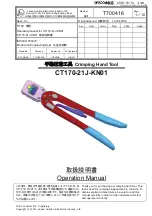
37
General Sharpening Procedures
it will probably neither be straight nor at 90° to the spine
of the chisel. The fi rst thing you will have to do in this
instance is grind the end of the chisel square. When this
is done you will now have reached the state where the
used chisel will be exactly the same as the new chisel, a
good square end but blunt.
For reasons known only to the world’s corner-chisel
manufacturers, I have always found corner chisels to be
fairly soft, almost never harder than Rc58. Many antique
ones are as low as Rc54 or Rc55. This means that they
can readily be fi led, and a fi le is unquestionably my
fi rst choice of sharpening tool for a corner chisel. You
have the necessary control to sneak up on a sharp edge
without overshooting it.
You should use a safe-edge fi le for the job; otherwise,
you will cause yourself some problems in the corner.
Although an auger-bit fi le has one end where the edges
are safe and another end where the faces are safe, it is
a bit small for most corner chisels. I recommend that
you grind the edge off a 6-in. or 8-in. mill fi le and use
it instead. For a chisel too hard for a steel fi le, you can
use a diamond fi le. You’ll almost certainly have to do
some work on the edge of the diamond fi le, because the
fi le face seldom comes out to the edge of the supporting
backing plate. You’ll have to dress the backing plate
fl ush with the fi le edge.
A 30° bevel angle is fairly standard with corner chisels,
though you will fi nd antique ones with higher bevel
angles. I suspect that this was partly an insurance policy
on the part of the original owner who wanted to be
absolutely sure that an edge didn’t fold in use, and partly
the tendency to increase bevel angles to save sharpening
time. Given the nature of use of a corner chisel, it would
seem that 30° should be about appropriate. I have used
them only in softwood and 30° was fi ne. In testy woods
like oak, 35° might be necessary.
Once the inside of the chisel is fi led, it should be honed
with a fi le-shaped stone, as fi ne as can be found. To
fi nish off the tool, put some green buffi ng compound
on the face of a stick and use it on the two bevels just as
you would a fi le.
It is important to keep the two cutting edges at 90° to the
spine of the tool. If they are swept backward, the heel of
the tool will constantly be forcing its way through wood
that is not yet free to be released. With the wings square
or with slight forward sweep the wood will release
freely. But realistically, if you get two straight edges
that cut well, just leave the thing alone. Be glad you
didn’t get a hook in the corner.
Japanese
Chisels
The traditional Japanese
chisel is quite different
from its Western counter-
part. First, it is a laminated
chisel with a very hard
steel face (Rc62 to Rc64)
laminated to a soft-steel
or wrought-iron back.
The use of very hard steel
requires the soft back
both for the damping
qualities and to provide
an element of toughness
that the steel face alone
would not have. Second, a
traditional Japanese chisel
has a hollow face for
faster sharpening and to
make it easier to maintain
fl atness. Japanese
chisels
are sharpened in the
same manner as Western-
style chisels but normally
require higher bevel angles
to avoid edge chipping.
Most traditional construction, cabinetry and interior
trim in Japan is with softwoods. To avoid crushing of the
fi bers it is necessary to have particularly keen chisels, but
there is no great toughness requirement since they are
subjected to little distortional force from the softwood.
The use of a very hard high-carbon blade makes sense
under these circumstances. The high-carbon steel will
take a very fi ne edge if the brittleness can be tolerated.
If you intend using traditional Japanese chisels for
Western hardwoods you are going to have to use
higher bevel angles than you are accustomed to. For
most purposes, an extra 5° should be suffi cient, but for
mortise chisels you may need as much as 10° more than
you would use on a Western chisel.
Use a safe-edge mill file to sharpen the inside bevels of a
corner chisel.
Traditional Japanese chisels,
which have a hollow face
(left), are usually sharpened
at higher bevel angles than
Western chisels. (Photo by
Susan Kahn)
Summary of Contents for Mk.II
Page 6: ...vi Veritas Mk II Power Sharpening System ...
Page 14: ...8 Veritas Mk II Power Sharpening System ...
Page 20: ...14 Veritas Mk II Power Sharpening System ...
Page 33: ...27 Exploded Assemblies Master Parts List 5 3 13 9 7 2 14 24 21 1 6 22 20 19 18 17 16 15 23 4 ...
















































